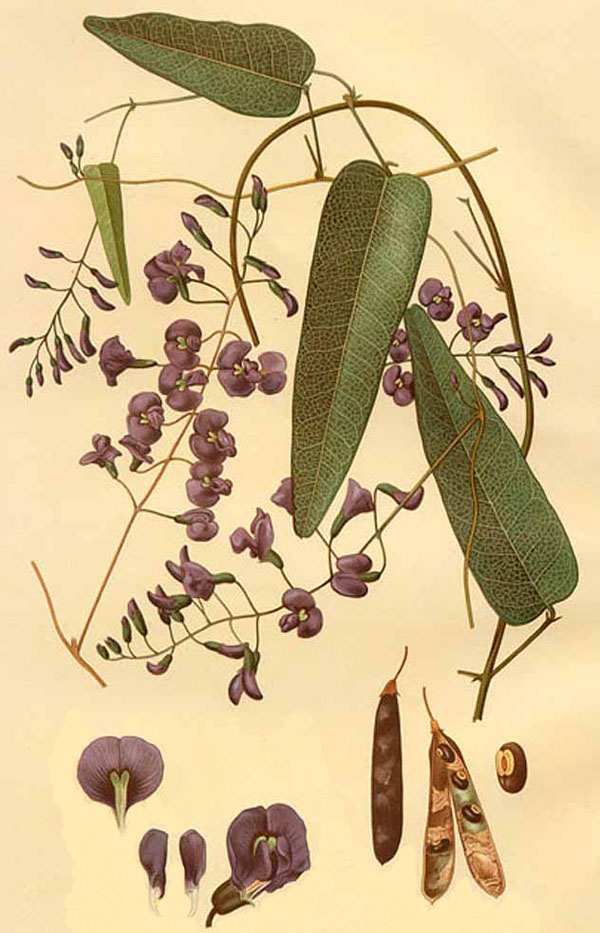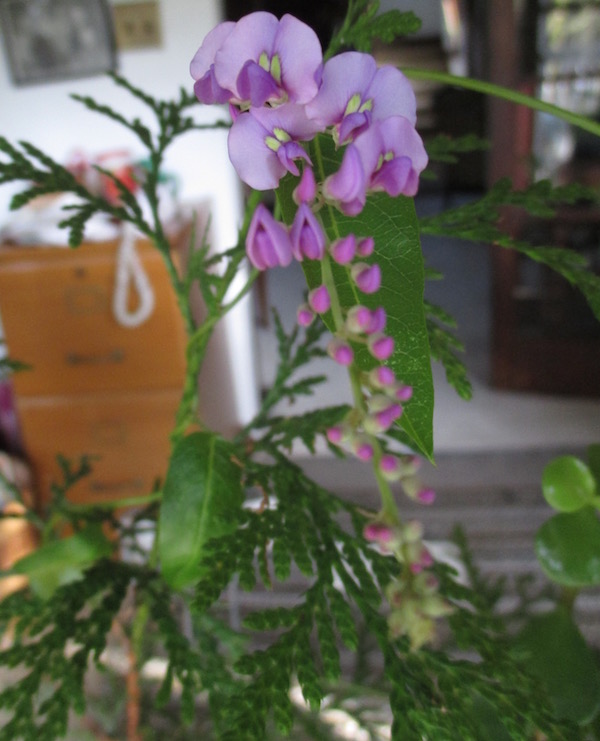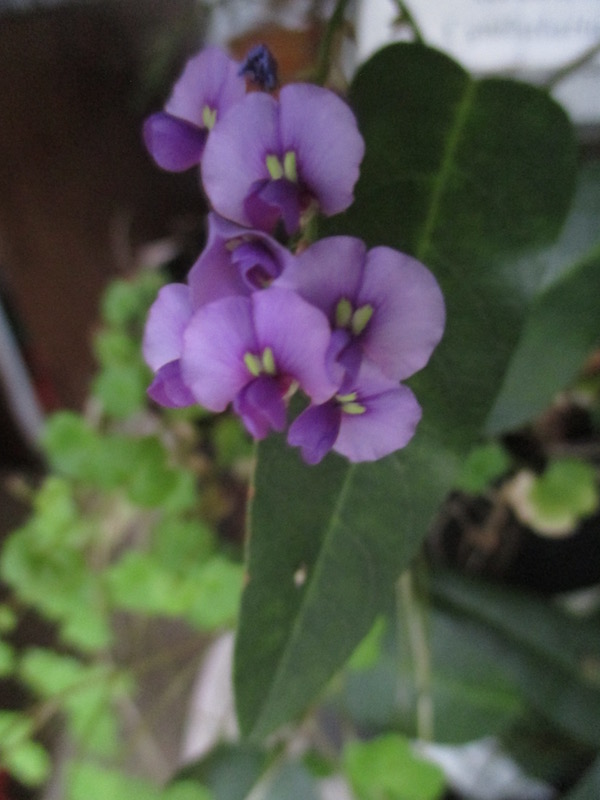Plant of the Month: January 2016
|
| Australian Sarsaparilla |
| Hardenbergia violacea (Schneev.) Stearn 1940 |
| = Hardenbergia monophylla (Vent.) Benth. 1837 |
| = Glycine violacea Schneev. 1793 |
| = Kennedia monophylla Vent. 1805 |
LEGUMINOSÆ ; Pea Family
|
| In August, I bought a tiny specimen of a rooted cutting of an Australian vine. First, I kept it outdoors. When winter came to Seattle, I brought it inside, putting it in a pot 4 inches deep and 4.5 inches wide. Since late December it has been blooming prettily, and twining its slender stems around counterclockwise. Since I have demonstrated that it can be grown indoors, and it is mentioned in at least four houseplant books, in spring I will plant it outside in the ground --and see how it fares there. It is a species that is variable, and the clone I obtained is likely one of the most cold-tolerant and vigorous ones. |
| The genus Hardenbergia was first named in 1837, and commemorates Countess Franziska von Hardenberg (Francisca Hardenberg von Hügel) (____ - 1853), the sister of Baron Carl A.A. von Hugel (1795 - 1870), Austrian traveller and horticulture patron. The genus has 2 or 3 species, all Australian. Most well known and widely cultivated is the species I have: Hardenbergia violacea. It is an evergreen ground cover or vine. The foliage is smooth and dark green, the leaves slender. In winter or early spring it bears lovely scentless flowers that vary from white to rose, violet or purple. On some specimens, slender seedpods about an inch and a half, or inch and three-quarters, form. |
| This species is native in SE Australia & SE Tasmania. It is cultivated in warm temperate and subtropical areas of the northern hemisphere. English names include False Sarsaparilla, Australian Sarsaparilla, Vine Lilac, Purple Coral-Pea, Native Lilac, Lilac Vine, and Native Wisteria. Some of these names are applied also to its W Australian cousin Hardenbergia Comptoniana. |
| The four genera most closely related to Hardenbergia all are recorded as having species eaten by humans: Kennedia, Pueraria (kudzu), Shuteria, and Vandasina. |
| There is uncertainty as to Aboriginal use of Hardenbergia violacea as food. Certainly, however, early white settlers --and their descendants-- have eaten it. Due to leaf similarity, its roots were used like the Australian intensely sweet Sarsaparilla (Smilax glyciphylla), as a flavoring. Hardenbergia violacea flowers and seedpods also are reported edible. Its leaves have been used to make tea. To me, both its leaves and flowers taste bland, like most other pea-family plants such as vetches, beans and kudzu. Presumably, they are also notably nutritious. |
| Genus Smilax belongs to the family Smilaceæ and it includes 250 to 350 species widespread in temperate to tropical regions around the world. I know of at least 50 of those species having been used by humans for eating, or to flavor food. |
| To grow Hardenbergia violacea outdoors in a temperate climate that gets killer frosts, try to obtain a hardier clone such as 'Happy Wanderer' and plant it where it will be able to climb something such as a fence. Or grow one in a hanging basket or in a pot with a sturdy trellis. |
| Cultivars of Hardenbergia violacea include but are not limited to these 30: |
| 'Bliss' |
| 'Blushing Princess' |
| 'Bushy Blue' |
| 'Bushy Pink' |
| 'Canoelands' |
| 'Carpet Royale' |
| 'Danielle' |
| 'Edna Walling' |
| 'Flat White' |
| 'Free n Easy' |
| 'Happy Duo' |
| 'Happy Wanderer' |
| 'Icicle' |
| 'Jane Prowse' |
| 'Meena' |
| 'Mini Ha-Ha' |
| 'Pink Cascade' |
| 'Pink Fizz' |
| 'Purple Falls' |
| 'Purple Spray' |
| 'Rambospray' |
| 'Redlands' |
| 'Regent' |
| 'Rosea' |
| 'Sweetheart' |
| 'Variegata' |
| 'White Crystal' |
| 'White Out' |
'Winter White'
|
| Since the plant is not weedy, and is so pretty, and edible, people with access to different cultivars should try to learn which ones are best to eat. |
The expert drawing below is by Edward Minchen, from The Flowering Plants and Ferns of New South Wales (1895 - 1898).
Back |

Hardenbergia violacea drawing
|

Hardenbergia violacea; photo by ALJ
|

Hardenbergia violacea; photo by ALJ
|
|
|

